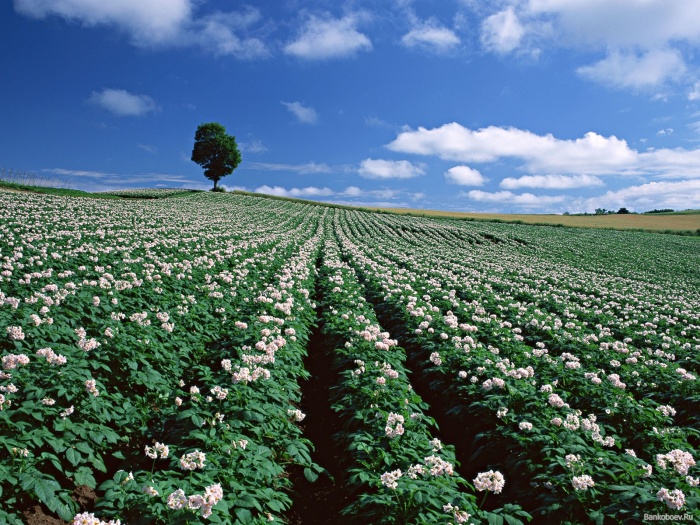 Potato is one of the most beloved products for many people. And, despite the fact that most gardeners have been cultivating this crop for a long time, not everyone knows how to do it right. In fact, growing potatoes in your garden is a rather time-consuming task, with many nuances.
Potato is one of the most beloved products for many people. And, despite the fact that most gardeners have been cultivating this crop for a long time, not everyone knows how to do it right. In fact, growing potatoes in your garden is a rather time-consuming task, with many nuances.
And so that the works are not lost in vain, you need to know, and most importantly, perform the basic methods of cultivating it. One of these techniques is the hilling process. This is a very important crop care procedure that helps make it rich and tasty. Why grow up potatoes when it is worth starting this process and how to do it right? In all these matters, we will understand this article.
Content
- 1 Why spud potatoes
- 2 The main reasons for hilling potatoes:
- 3 The rules of hilling potatoes
- 4 When to start hilling potatoes
- 5 In what weather do you need to spud potatoes for the first time
- 6 How many times do you need to spud potatoes
- 7 Do you always need to spud potatoes?
- 8 There are several other conditions under which hilling of potatoes is not required:
- 9 How to spud potatoes manually: process features
- 10 Reviews
Why spud potatoes
Many summer residents with experience produce regular earthing up of potatoes, but sometimes even they can’t answer exactly what it is for and what is the use of it. In addition, recently, from various experts, it has become increasingly common opinion that when growing a crop, you can do without it. So what is hilling and why is it needed?
Hilling is an agricultural procedure, the meaning of which is to rake a small amount of soft and loose soil to the bottom of a potato bush. This is a very important stage in the agricultural technique of growing potatoes, which helps to maintain the maximum amount of the crop (if you ignore it, there is a risk of losing 20-30% of the crop). The need for this procedure is explained by the vegetative features of this crop.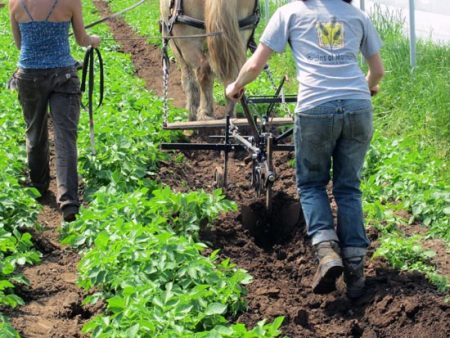
The fact is that potatoes have side shoots called stolons. They grow below the soil, have an elongated shape, develop fairly quickly and die off. On the stolons, in turn, other processes appear. They are the potato tubers. So, when hilling, young shoots are under the ground, as a result of which the plant is forced to give new sprouts. This contributes to the emergence of new roots and tubers, as well as the preservation of moisture. Thus, the bush acquires a strong root system, grows and acquires a powerful leaf mass. And its root crops are actively formed and grow.
In addition, there are other reasons for hilling potatoes that are not associated with the appearance of additional stolons.
The main reasons for hilling potatoes:
- thanks to this procedure, not only the number of new stolons increases, but also the quality of the soil structure improves. It becomes more loose and breathable. And this, in turn, contributes to the ingress of air and moisture into the root system of the plant. As a result, the potato bush is less sick and develops much faster. This is especially important for treating plants in wet or dense soil.
- young tubers are protected from sudden changes in temperature. In our area, the climate is unstable, and you need to be prepared for various weather disasters. This is especially true for those who plant potatoes in early spring. Sudden frosts and even snow can fall at this time. And during the day the soil does not warm up completely.The layers of earth forming hills serve as a kind of blanket. They reliably cover young bushes, protecting them from the cold, and your crop - from losses,
- reduces the amount of weeds in the rows of potatoes. The most harmful is the wheat grass creeping. It penetrates into tubers and violates their commercial value. On sprinkled rows, weeds are much more difficult to break through a thick layer of earth. Moreover, without access to light, they die at all,
- protection against colorado potato beetles. These insects greatly harm young potato shoots. Mounds from the earth, which are created during hilling, reliably cover the stolons from their raids. In addition, ridged furrows and rows are much easier to process with special tools to destroy harmful bugs,
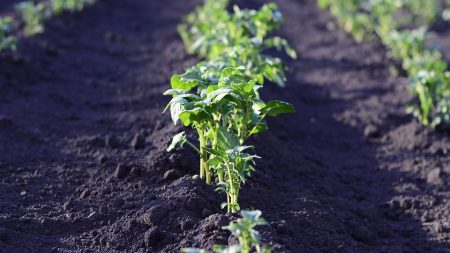
The rules of hilling potatoes
It is important to know the basic rules of hilling and not to miss the moment when you need to do this for the first time. Experienced gardeners already know all the features of their site, and therefore choose the time and methods of hilling intuitively. For beginners, this is difficult. After all, they are interested in such questions: when to start hilling potatoes and how many times to repeat the procedure in the future.
In fact, the methods and timing of this event depend on various factors. Among them:
- climatic conditions
- soil type
- root planting time.
When to start hilling potatoes
There is no consensus on the question "when to start hilling potatoes". Some agronomists are sure that the sooner this procedure is performed, the better. Others insist that weather conditions be considered. Still others are advised to focus on the planting dates. In fact, all of these opinions are correct.
The first hilling should be performed when the first shoots appear. At this time, they are still small and usually have six leaves on each stem. It is recommended to start the procedure when the first bushes grew by 5-20 centimeters.
Such a wide range is due to different climatic conditions. Therefore, in addition to seedling height, you need to focus on the weather. For example, in the middle lane, potatoes are usually planted at the end of May, so the earthing will fall at the beginning of June. But if the spring is late and cold, the soil warms up worse, perhaps even frosts will appear, and then the sprouts will sprout more slowly. In this case, you will need to completely sprinkle low shoots, protecting them from low temperature.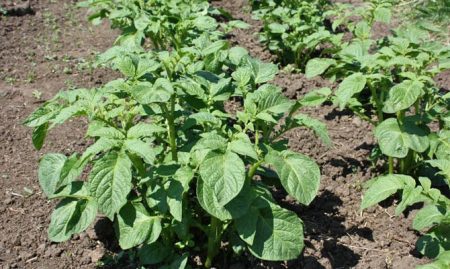
If spring is early, the soil warms up faster, and the tubers will sprout quickly. In this case, with hilling, you can wait a bit, and if you do this, then fill up young plants not completely, so as not to slow down their growth.
In what weather do you need to spud potatoes for the first time
The most favorable time for the first hilling of potatoes is the period after watering. But instead of a watering can or hose, you can use the weather conditions. Moisture-saturated soil after rain is ideal for creating hills around potato stalks. Moreover, under such conditions, shoots begin to grow even faster. Work should be carried out in cloudy weather early in the morning or in the evening.
On a hot sunny day, it is better to abandon this event. This time will be uncomfortable for both the gardener and the plant. Indeed, when processed under the rays of the scorching sun, the potato bushes wilt, receiving, although small, but still damage. In addition, in hot weather, the soil is heated in the sun. Working with it will require a lot of physical costs and bring minimum benefits. And if you sprinkle sprouts with such soil, you can just burn them.
But what if the summer turned out to be hot, the soil with potatoes dries up and at the same time the hilling time is right? Under such conditions, it is recommended to water the beds first, and only then proceed to the processing of the bushes.
At the first hilling of potatoes, it is worth paying attention to the layer of earth, which sprouts are sprinkled with.They should be no more than 7-10 centimeters. If there is too much soil, it will not help the plant, but will kill it. After all, young shoots will not be able to break through to the sun.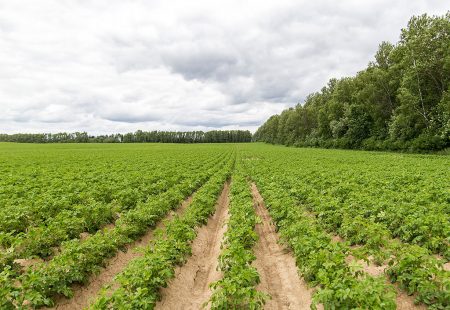
How many times do you need to spud potatoes
According to the rules of agricultural technology, for the whole season it is recommended to perform 2-3 hilling procedures. Almost all experts agree that it is important to focus on the height of the stems and weather conditions.
Subsequent shelters are recommended for certain periods:
- the second hilling should be carried out in a week (depending on climatic conditions, - in 10-15 days). This is the time of the active formation of tubers, preceding the flowering of the culture. It is worth paying attention to the shoots that again appear above the ground. Ideally, if they reach a height of 20-25 centimeters,
- the third time they spud potatoes when the stolons grow to 30 centimeters. This time it is not recommended to completely cover the bushes with earth, you only need to sprinkle their bases and toss a little earth between the branches (and remember about ten centimeters). Thanks to this, the plant grows better in width.
There are rare cases when potato bushes are sheltered for the fourth time. This is necessary if their nests did not form along the ridge, but grew in breadth, or when the roots begin to peek out of the ground.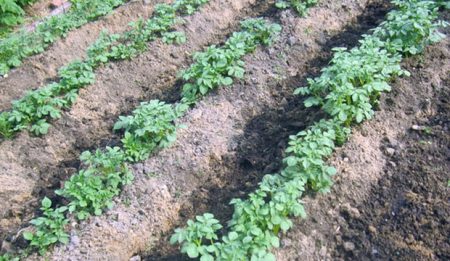
Do you always need to spud potatoes?
To this question, specialists who adhere to traditional methods of agricultural technology will give an affirmative answer. Summer residents with experience, seeing the benefits of this procedure, will agree with this. But beginners will be interested in a few nuances:
- Do I need to spud potatoes in rainy summers?
- Is it possible to spud potatoes during flowering?
In very rainy weather, hilling is not recommended. It is important to focus on the soil: if the earth is very wet, like dirt, it is worthwhile to postpone the procedure. This is explained by the fact that in too wet soil it is impossible to create the correct air exchange.
Until the moment when flowers appeared on the stolons, all bushes should already be covered with soil. During flowering, tubers begin to form. Therefore, if it is possible not to spud potatoes at this moment, it is better not to. If the procedure cannot be avoided, it must be done very carefully. Inaccurate work can damage the set tubers and ruin the future crop.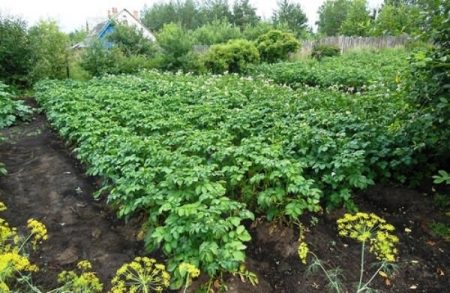
There are several other conditions under which hilling of potatoes is not required:
- if the plant is grown under a special black agrofibre. Thanks to the use of this material, all conditions are created for the growth and ripening of tubers, therefore, hilling is not required,
- when growing crops under a layer of straw, grass or tops. This method allows the potato to grow not in the form of a bush, but by spreading it on the ground.
How to spud potatoes manually: process features
Among gardeners, the most popular method of hilling is manual. But before proceeding with the process, it is important to remove all weeds from the beds and inspect the bushes. Their leaves should be healthy and green. And the grass, on the contrary, is recommended to leave. When it dries, it will perfectly protect the root crop from sunlight.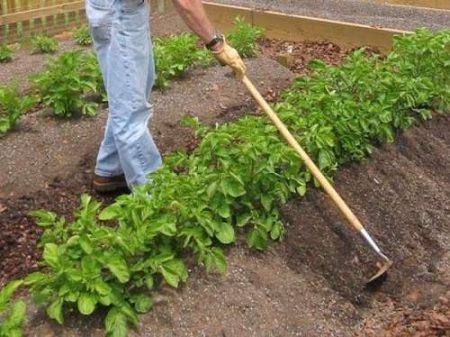
For manual hilling, it is important to choose a strong and reliable tool. A chopper or hoe is best. It should be comfortable and heavy enough to quickly spud potatoes. The hap can have a different shape:
- trapezoidal
- triangular
- with pointed edges.
How to spud potatoes? There are at least three ways:
- raking land to the bush from all sides. Thus, each bush is processed separately. The result is a kind of bouquet of stems. To better understand this process, you can watch the video “How to Spud Potatoes”,
- the second method involves spreading the stems in different directions and falling asleep in the middle of the bush. You can do this in rows: first one side, then the other,
- use of a manual hiller. Its design can be different: home-made or store-bought, in the form of a chopper or a plow, designed for two people. In this way, the soil is processed only between rows, which greatly facilitates the process.
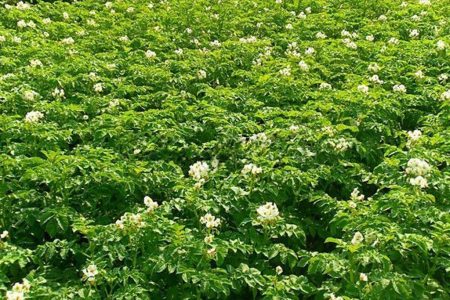
Advantages and disadvantages of hilling potatoes
Covering potato bushes with land has many advantages. The main one is that the soil is enriched with oxygen, which improves the quality of the crop. But besides those considered earlier, there are other advantages of hilling. Among them:
- Harvesting procedure is facilitated. If hilling is done regularly, then when harvesting it will be easier to dig up tubers. After all, for this you will not need to bury the tool deeply. In addition, earthen plantings are easier to cultivate by cultivators and other agricultural machinery,
- the bushes are correctly formed, have the desired shape and height. Thus, they do not obscure each other and are well lit,
- during rain or during manual irrigation, water quickly penetrates to the underground organs of the bush. Thanks to this, it receives more moisture and develops faster,
- overheat protection. The sun can also adversely affect young shoots. If the soil temperature reaches 26 ° C, the stems stop growing. And the tubers sprinkled with soil do not turn green in the sun and do not pick up solanine,
- high mounds around the bushes protect young stems from strong winds, not allowing them to bend and break. It also increases productivity.
As you can see, there are many pluses. But are there any flaws? They can occur if you do not follow all the rules of hilling or do it at the wrong time. If you do this sloppy, you can touch the roots or tubers. A damaged plant will begin to wilt, as a result of which you can lose the entire crop from the bush.
Reviews
On the thematic forums, you can find a lot of reviews from people who use hilling potatoes. There are different points of view on how to properly perform the procedure and whether it is worth resorting to it at all. Here are some of them:
“If you plant potatoes finely, then you need to spud to stimulate the formation of additional roots. If deep, then loosening is enough ”
“I have a huge site, so I do the hilling only once. It’s enough for me. ”
“... I have a good walk-behind tractor. I process potatoes with it ”
So, from the foregoing, we can conclude that hilling is an important procedure that helps to improve the crop. Whether or not to apply it is up to you. But if you still decide to resort to hilling potatoes, you need to do it right. Then the result will be perfect.




 Description and description of varieties in Belarus with a photo
Description and description of varieties in Belarus with a photo Do I need to pick flowers from potatoes: why do they do it
Do I need to pick flowers from potatoes: why do they do it When to dig potatoes: timing and availability of new potatoes
When to dig potatoes: timing and availability of new potatoes How to grow a good potato crop: various methods and methods, planting and care
How to grow a good potato crop: various methods and methods, planting and care
Summer is very hot and rainy, while we wait for the earth to dry out, it will rain again, the potatoes have already bloomed. We don’t know what to do, it doesn’t work out to spud potatoes, is it possible to leave it without hilling up?